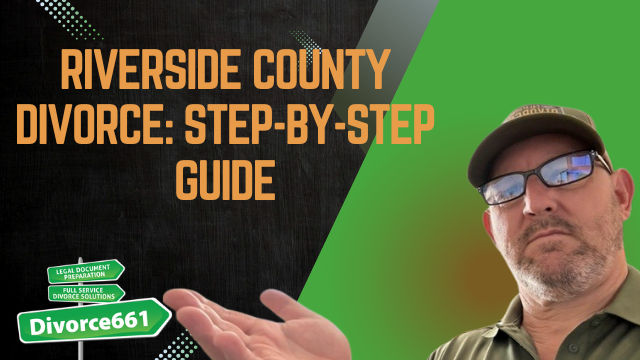Riverside County Divorce: Step-by-Step Guide
Hi, I’m Tim Blankenship from Divorce661. If you’re thinking about filing for divorce in Riverside County, this guide walks you through the process step by step so you can get it done right the first time. I’ll cover the forms you need, how to serve your spouse, mandatory financial disclosures, the judgment phase, common mistakes to avoid, and how Riverside’s eFiling can speed things up.
Overview: What to expect
Filing for divorce can feel overwhelming, but the Riverside County process follows a clear sequence. Below is a practical roadmap you can follow to move your case from initial filing to final judgment as smoothly as possible.
Step 1 — Prepare and file the initial forms
The divorce officially starts when you file your paperwork with the Riverside Superior Court. At minimum you’ll need to prepare and file:
- Petition (start of the case)
- Summons (notice to the other spouse)
- UCCJEA (if you have minor children — this identifies other jurisdictions that may have child custody authority)
Make sure you file the correct number of copies and keep the court-stamped copy for your records. Filing these documents is what officially puts the case on the court’s docket.
Step 2 — Serve your spouse
After filing, your spouse must be legally served with the filed copies. There are two common options:
- Service by a third party (a professional process server or a person over 18 who is not a party to the case).
- If your spouse is cooperative, use a Notice of Acknowledgement and Receipt so they can acknowledge receipt without formal personal service.
Once service is completed, you must file a Proof of Service with the court to confirm that your spouse was properly notified. The court won’t proceed until service is correctly documented.
Step 3 — Exchange mandatory financial disclosures
Before you can finalize a divorce, Riverside requires both parties to exchange financial information. Required documents typically include:
- A schedule of assets and debts
- An income and expense declaration
These disclosures are mandatory even in amicable cases. They ensure both parties understand the full financial picture before negotiating a settlement or asking the court to enter a judgment.
Step 4 — Move to judgment (if you agree)
If you and your spouse reach agreement, you’ll prepare a Marital Settlement Agreement outlining how assets, debts, custody, support, and other issues will be handled. Then you submit a final judgment package to the court.
Riverside County allows eFiling, which can significantly speed up the submission and approval of your judgment package — but only if the paperwork is completed correctly. Incorrect or incomplete disclosures are a common reason judgments are rejected.
Real client example — Temecula couple
We recently helped a couple in Temecula who wanted a quick, peaceful resolution. They tried to handle the divorce themselves but got stuck when their disclosures were incomplete and the judgment was rejected. We stepped in, corrected the forms, e-filed the complete judgment package, and their judgment was approved within a few weeks. That’s the kind of time- and stress-saving advantage you get when the paperwork is done right.
Common mistakes and practical tips
- Incomplete disclosures: Missing or inconsistent financial forms often cause delays or rejected judgments.
- Improper service: Failing to serve or to file proof of service will halt your case.
- Errors on forms: Small mistakes — missing signatures, wrong dates, mismatched figures — can lead to rejections in eFile.
- Assume paperwork is mandatory: Even if you’re amicable, you still must exchange disclosures and follow court procedures.
How Divorce661 can help
At Divorce661 we specialize in full-service, flat-fee divorces for amicable couples in California. We handle:
- All paperwork and court filings
- Correct completion of disclosures and judgment packages
- E-filing with Riverside County to speed up approvals
- A process that avoids court visits and traditional attorney fees
If you’d like help, visit Divorce661.com to schedule a free consultation. We walk you through each step so your divorce is handled quickly, correctly, and with less stress.
Conclusion
Filing for divorce in Riverside County follows a straightforward sequence: file the initial forms, properly serve your spouse, exchange mandatory financial disclosures, and submit a complete judgment package. eFiling can speed things up—if the paperwork is correct. If you want a smoother path through the process, consider getting professional help so your judgment isn’t delayed by avoidable mistakes.
For a free consultation and more information, visit Divorce661.com.

